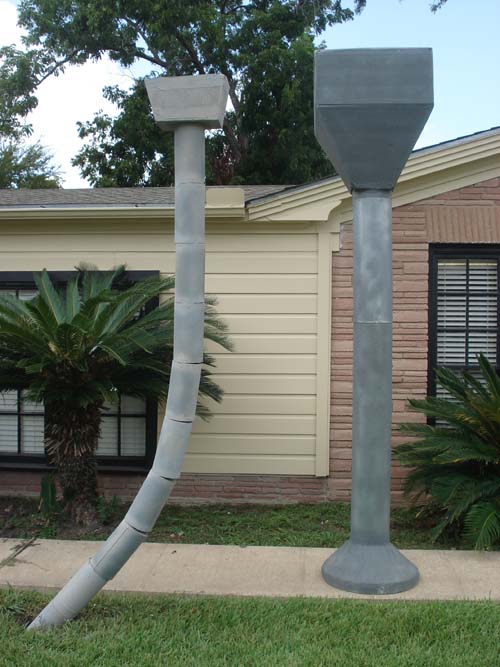The Competition Hopes They are Vertical
Hoping for a good outcome is not a good foundation repair strategy. Unlike our competitors, our repair method (Bell Bottom Piers) is not based on hope but rather certainty. What are we talking about?

Our competitors use hydraulic jacks to push concrete cylinders into the ground. The problem is that once they go into the ground the contractor has no method to confirm that the column of concrete piles is vertical. And it must be vertical if it is going to support the foundation. There are many different underground obstructions and/or challenges from tree roots to rocks to different soil densities.
Confirmation
We know that sometimes these concrete cylinders do manage to “line up” vertically. We also know that sometimes the column skews off on an angle. We know this because we have dug up some of the work of previous contractors to show homeowners what has happened. It is usually quite a surprise for a homeowner.
Bad Result – Failure
When a column of pushed piles skews off on an angle it can not offer the needed support for the foundation and home. The neighboring columns of pushed piles must accept the additional weight but this is impossible because they are at their maximum limits. This is where the “factor of safety“ comes into play. This is an engineering term that explains how a structure or column can bear (accept) a certain amount of weight. Since the weight of the home was used to drive the concrete piles into the ground, the factor of safety is 1. That means the column of pushed piles can only bear the weight of that portion of the foundation and home in its direct location. It can not bear any additional weight. For example, if 3 columns of pushed piles were intended to support a section of foundation, and one of the columns skewed off at an angle, the other two can not bear the additional weight. This would result in failure.
A skewed column of pushed piles is probably the primary reason for so many “relevels” in the Texas market. When one or more columns of pushed piles is skewed at an angle it is a failed support structure. There is no recovery. A “relevel” will generate some temporary relief because of the “skin friction” of the column with the soil but in these situations the failure of the repair job is irreversible.
Some of our competitors are asking their customers to pay for “relevels.” They are asking customers to pay more money for a failed foundation repair job? Kinda bold isn’t it?
The Question to Ask
The next time you speak to a foundation repair contractor that proposes to push some concrete piles under your foundation’s perimeter beam ask him this question:
How do you know that the column of pushed piles (usually 10 to 20 feet) is vertical?
The correct answer is: “I don’t know.”
If the repair contractor gives you any other answer then he is not telling you the truth. There is NO guarantee, no confirmation method, no assurance that the column of pushed piles is vertical. This applies to both connected and unconnected columns of pushed piles. If it is not vertical then it is a doomed support structure.
On the Other Hand, Bell Bottom Piers
Certainty. Before we pour the concrete for a Bell Bottom Pier the excavated hole is inspected by an independent engineering firm. The depth, position, angle, and all diameters are confirmed. We know that the Bell Bottom Piers will meet the specifications. That’s certainty, not hope.
Conclusion
The bottom line – The pushed pile method is based on hope. The contractor hopes the concrete piles are driven vertically. The homeowner also has the same hopes – except the contractor didn’t really explain it that way. Do you really want a foundation repair method that is based on hope rather than certainity?
Oh, did we mention that the “footprint” or support area of a column of pushed piles is less than 8% of the footprint of a Bell Bottom Pier? We should. That is part of the difference between low quality and high quality foundation repair methods. You can read more about it here.
